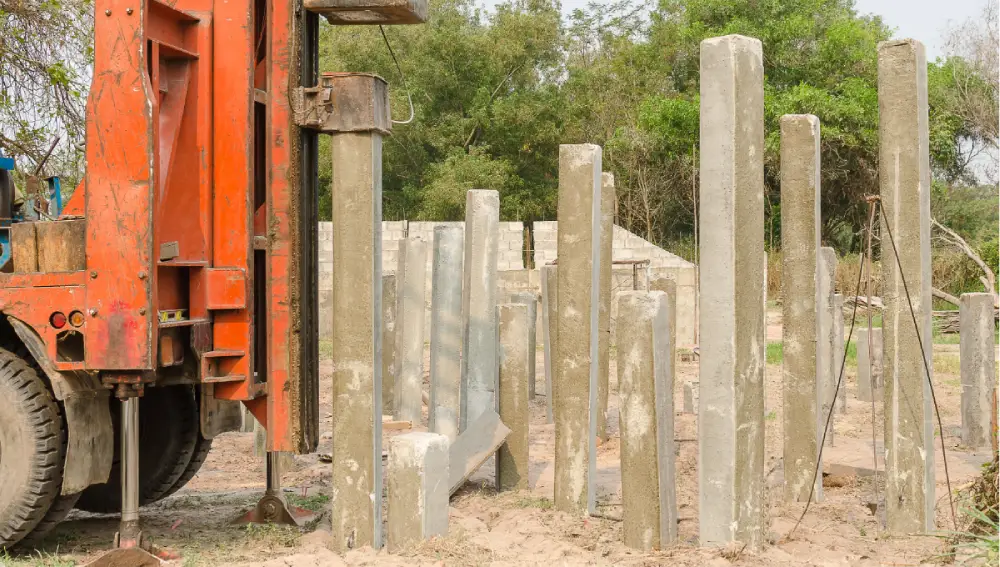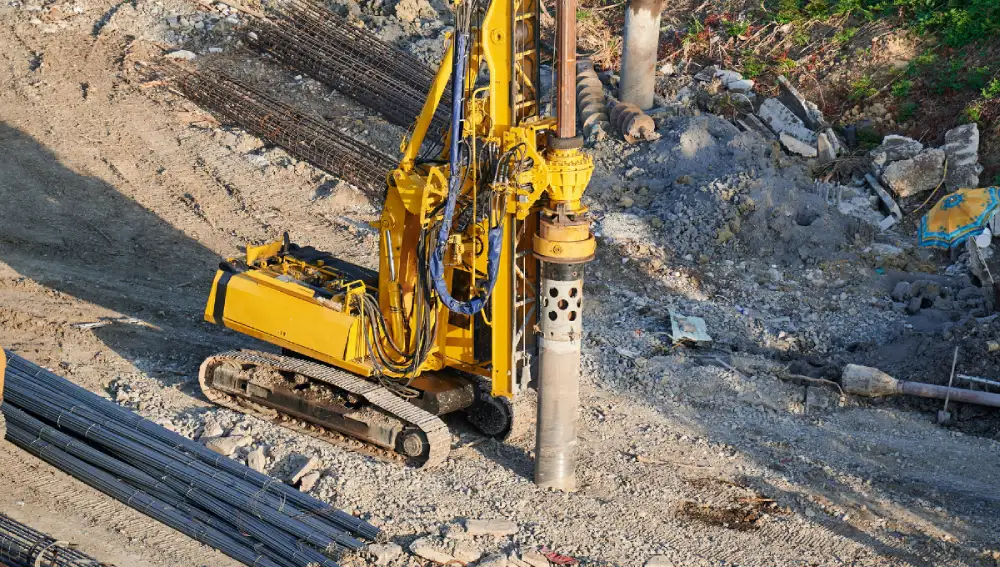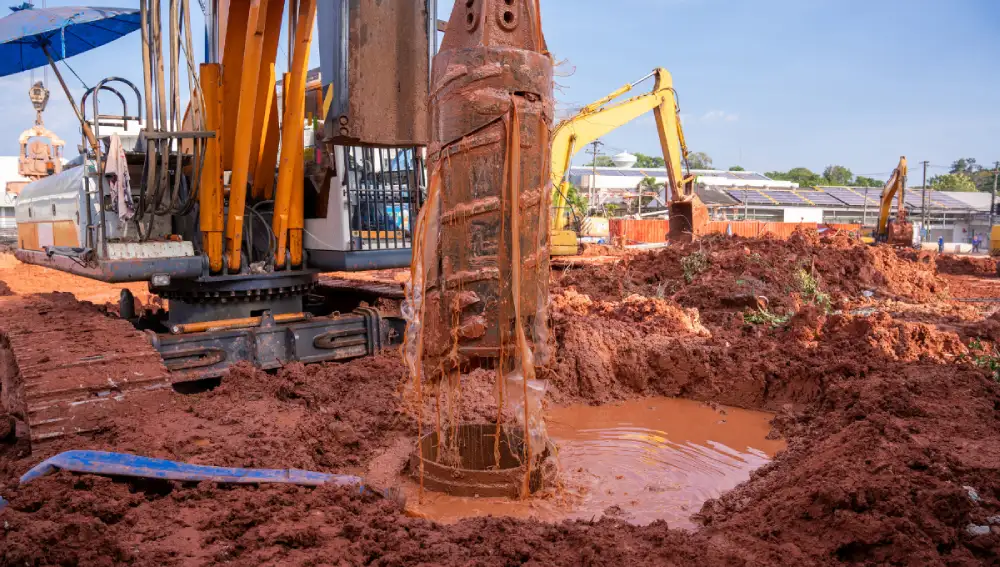Piling is a cornerstone of the construction industry that secures the foundation of a building before beginning the infrastructure on top. It is a key tool that contractors can use to enhance the safety and reliability of any project.
Pile foundations are designed by considering the soil type and load conditions. They are excellent at carrying heavy loads in tall structures and can be constructed from different materials, including steel, timber, precast, or in-situ concrete, with ideal characteristics.
With this article, you can learn about piling in construction and its categorization in detail:
What is Piling in Construction?

In general, piling in construction is a process of driving long, slender columns into the ground to add fundamental support to the structures. To ensure structural stability, piling transfers the load of the building deeper into the rock layers or stable soil.
Its weight, circumference and shape vary from one another based on the demand of the construction project and soil condition. Pile foundations distribute the weight or load of heavy construction equally to a wider surface area. It particularly works well for high-rise buildings, structures on water or soft ground, and bridges.
Types of Piling Used in Construction
Before starting construction, contractors can decide on the piling types to enhance the foundation strength. This is based on certain significant conditions of the construction area such as climate, soil type and other relevant factors.
With that information, they consult with architects and decide the suitable piling type. It is categorized by either the materials or the purpose of the design.
Piling Types Based on Functions

Sheet Piles
It is a kind of driven piling made with a series of interlocking steel sheets. A permanent or temporary retaining wall can be created on a construction site where extensive excavation is required.
Sheet piling is quite budget-friendly and best-suitable for areas where temporary soil retention is essential. The sheets can be reused at different construction sites once the ground work is done.
Friction Piles
Friction piles looks cylindrical and is capable of handling more weight. A friction pile uses its full height to transfer the loads that the structure generates into the soil. The amount of load that the friction pile can handle is directly proportional to its length.
Bored Piles
Bored piles are established for construction areas where large holes are made in the ground and filled with concrete. Compared to other piling types, this is very effective and distributes the load equally below the ground, which is ideal for structures, including bridges and flood protection.
Driven Piles
Driven piles are hammered into the ground before constructing a building with the use of vibration. This is well-suited for soil that includes contaminants, non-cohesive soils, and the ground with a high water table.
This piling type is not suitable for saturated or silty soils where the area has a poor drainage capacity. It typically includes materials such as steel, concrete, and timber.
Mini Piles
Mini or micro piles are for smaller areas where the access is restricted to install mini-sized piling rigs. It has many options based on the domestic and commercial development of that particular city.
Piling Types Based on Material
Timber Piles
Timber pile is a prime choice for piling beneath embankments and long cohesion piling. It is essential that the timber should be in a good condition, ensuring it will not be attacked by insects.
Steel Piles
Steel piles are extremely strong and capable of holding high amounts of stress, often used to create H-piles. It works well with end-bearing piles that come in numerous sizes to meet the demands of different construction projects.
Steel is the most suitable material for constructing highway bridge piers; however, it is susceptible to corrosion and doesn’t provide consistent friction.
Applications of Piling in Construction
Piling is a critical technique used in various applications that ensures the durability, stability, and support of buildings. Here’s a breakdown of key applications:
Building Foundations
Piling creates strong foundations for buildings or structures, specifically for areas with unstable or weak soil. By transferring the building loads equally to deeper, it remains safe and secure. This is well-suited for commercial structures, high-rise buildings, and other related construction areas.
Bridges and Flyovers
These structures usually require robust support and deep foundations to handle high dynamic loads and withstand the forces of heavy usage. Piling distributes loads to the ground and supports the elevated sections with enhanced durability and stability.
Marine Structures
Marine structures like offshore platforms, docks, jetties, or piers strongly depend on piling for stability. They provide essential support to these structures to withstand the harsh marine environment. The challenging conditions are unavoidable including tides, corrosive saltwater, and water currents.
Advantages of Piling
Improved Load Distribution: Effectively transfers the load into the ground, deeper soil layers.
Versatile Applications: Works well for diverse soil conditions and various construction projects.
Minimized Settlement: Reduce the risk of structural damage and uneven settlement.
Durability: Ensures high resistance to environmental factors and long-lasting support.
Environmental Adaptability: Efficient in handling challenging environments like seismic or waterlogged areas.
Conclusion
Piling in construction is an essential technique for building construction, ensuring the durability and stability of structures for a long time. From the foundations of houses to expansive bridges, piling withstands any harsh environmental conditions and challenges. The contractors are about to choose the wise option based on the condition of the construction site and the type of project involved.
FAQs
Piling is best suitable for constructions such as bridges, flyovers, building foundations, and marine structures like retaining walls, docks, and offshore platforms.
The choice of pile depends on certain significant factors including environmental conditions, soil type, load requirements, and some specific needs of the construction project.
When using piling in constructions, you need to uncover some common challenges such as dealing with difficult soil conditions, vibration control, and ensuring accurate alignment of piles.

